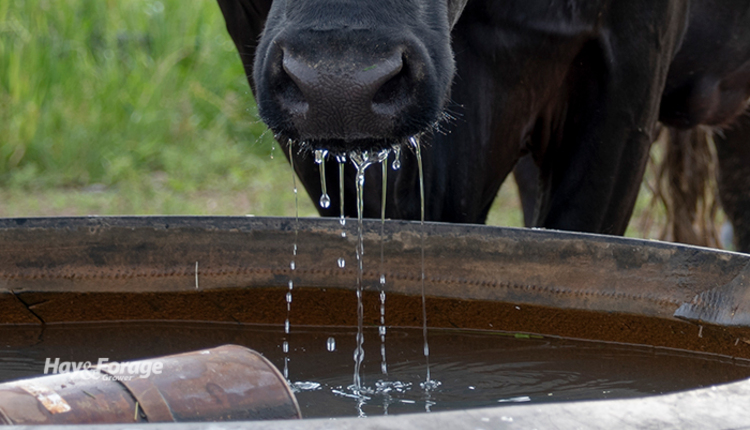
Water is the basis of life, whether it be for humans, plants, or animals. While water quantity is often questioned with drought conditions threatening supply, water quality is sometimes overlooked as an important aspect of grazing livestock production.
Caitlin Hebbert, with the Noble Research Institute, notes the amount of water animals consume depends on a number of factors, including growth stage, lactation, activity, diet composition, environmental temperature, and water quality. For example, the livestock consultant says a beef cow can drink 5% of its body weight per day, whereas a high-producing dairy cow can drink up to 20%. However, cattle will not drink enough to meet their needs if their water is low quality.
Water quality declines faster in the summer when evaporation rates accelerate, leaving behind higher concentrations of elements. Furthermore, the most common types of water sources for grazing cattle are ponds or impoundments and trough or tank systems, and water quality varies between these sources.
“In a study comparing the effect of water sources on average daily gain, cows, calves, and steers on pasture gained significantly more pounds per day when supplied with water pumped to a trough versus drinking directly from a pond,” Hebbert states.
Not only do the results show water from troughs is better quality, but they also illustrate the relationship between water quality, water consumption, and feed intake. Hebbert explains as water quality worsens, cattle drink less, which ultimately limits how much they eat and how much weight they gain.
Palatability matters
Although excess salinity, bacterial contamination, agricultural run-off, and blue-green algal blooms are all concerns regarding water quality, palatability is, too. In a similar study, calves and steers with access to water troughs weighed 9% to 10% more than animals drinking from ponds; however, there was no statistical differences in water chemistry or biological constitutes between the two sources.
“These gain increases likely reflect greater palatability,” Hebbert explains. “The aeration that occurs during the pumping process is thought to be one factor contributing to the increase in palatability for livestock.”
Hebbert also notes cattle with access to clean, aerated water from troughs spend more time grazing and less time resting than those that drink directly from ponds. She points out that animals will avoid drinking water that contains as little as 0.005% manure by weight, so even water from well-maintained ponds will likely be lower quality and less palatable than water pumped from wells or springs.
Water quality is essential on every farm, but it may have a bigger impact on stocker cattle than cow-calf operations. Since the goal of raising stockers is to maximize their average daily gain, it is critical to ensure water quality is in check to promote greater feed intake. Therefore, these animals may benefit more from access to water troughs than they would drinking from ponds.

Amber Friedrichsen is the 2022 Hay & Forage Grower editorial intern. She currently attends Iowa State University where she is majoring in agriculture and life sciences education-communications and agronomy. Friedrichsen grew up on her family’s diversified crop and livestock farm near Clinton, Iowa.

